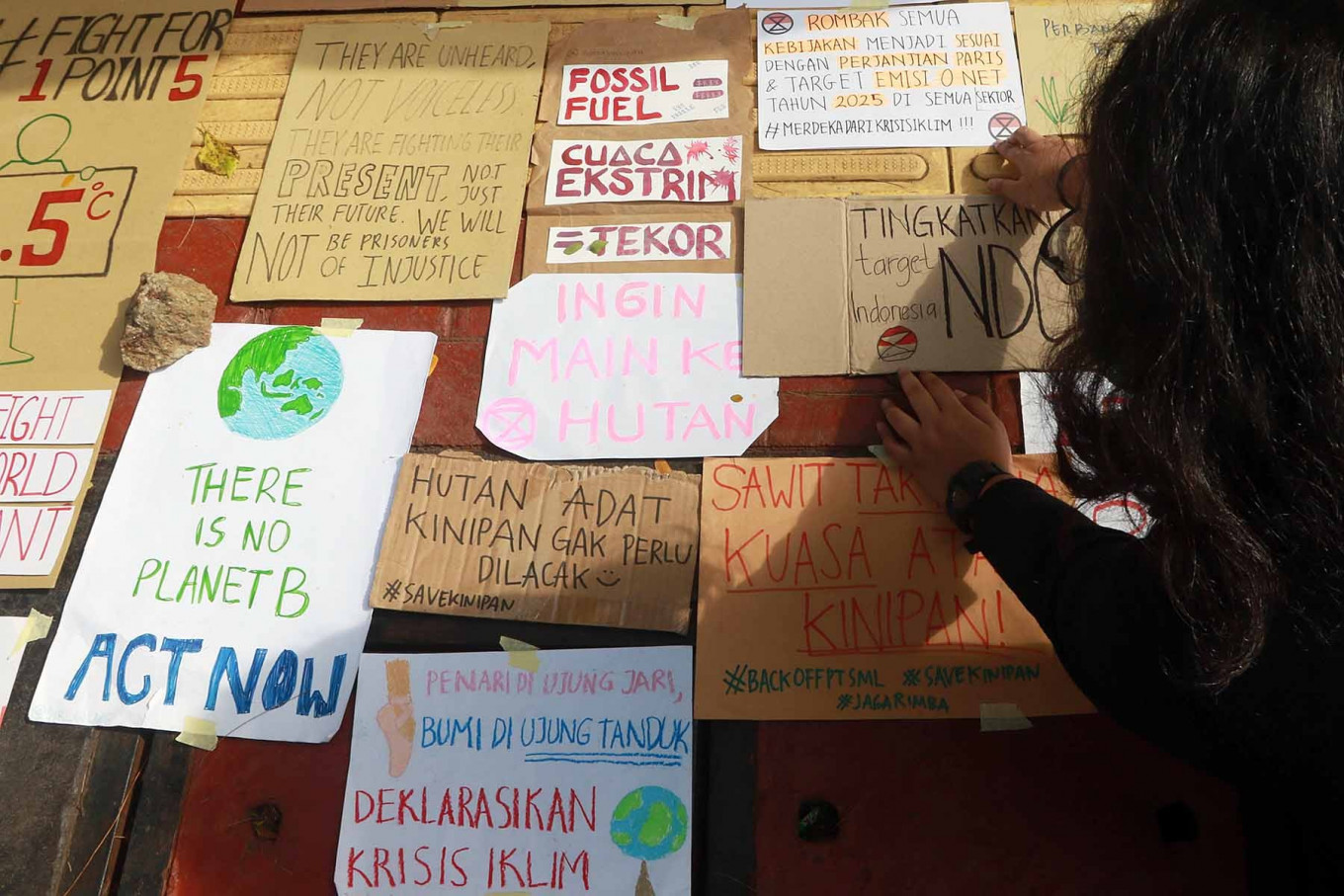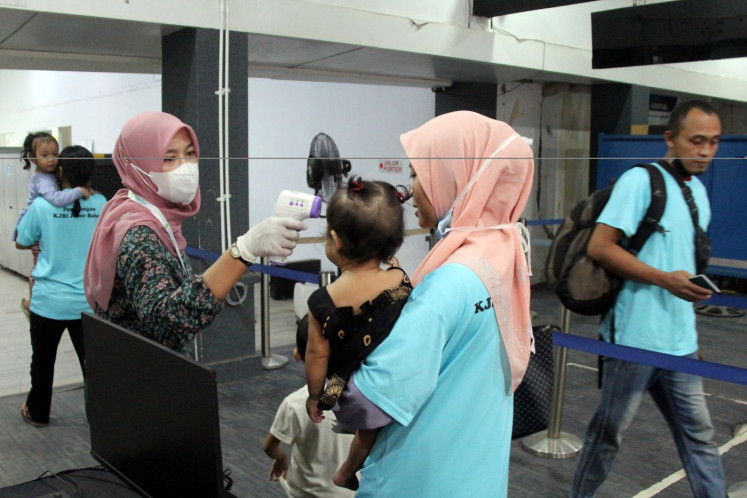Popular Reads
Top Results
Can't find what you're looking for?
View all search resultsPopular Reads
Top Results
Can't find what you're looking for?
View all search resultsCharting a path to carbon neutrality
Many global companies, including those in the heavy industry and energy sectors, have committed themselves to long-term reductions in greenhouse-gas emissions.
Change text size
Gift Premium Articles
to Anyone
 Civil groups place signs outside the Environment and Forestry Ministry building in Jakarta on Dec. 11 to demand that the government commit to reducing greenhouse gas emissions. Experts have urged countries to reduce their emissions further to limit the global temperature rise to below 2 degrees Celsius. JP/Dhoni Setiawan (JP/Dhoni Setiawan)
Civil groups place signs outside the Environment and Forestry Ministry building in Jakarta on Dec. 11 to demand that the government commit to reducing greenhouse gas emissions. Experts have urged countries to reduce their emissions further to limit the global temperature rise to below 2 degrees Celsius. JP/Dhoni Setiawan (JP/Dhoni Setiawan)
M
ore than half of global GDP is now generated in countries that have net-zero mandates, meaning that they will reduce, absorb, or abate greenhouse-gas emissions so that their economies become carbon neutral. Among them: China, the European Union, Japan, and South Korea. Many companies have also committed to achieve net-zero greenhouse gas emissions. And a number of investors, both private and public, are turning away from carbon-related assets.
Indonesia in general has not gone that far. In its submission to the 2015 Paris climate accords, the country committed to reducing emissions by 29 percent compared to the business-as-usual scenario in 2030—and up to 41 percent with sufficient international assistance. In effect, this allows Indonesia to continue to increase its emissions, but by less than would have occurred otherwise.
While Indonesia’s per capita emissions are relatively low—a little more than two metric tons per person, compared to 16.8 in Australia and 9.3 in Japan—it is the world’s eighth largest emitter, accounting for a little more than 2 percent of the total. Decarbonizing a growing economy like Indonesia’s can be challenging; its population is expanding, and it needs to grow to serve their needs. Moreover, Indonesia’s circumstances are unique.
First, the country’s coal assets produce low-cost electricity generation that is critical to its economic development goals. Shifting to lower-carbon renewables can be challenging as they tend to be considered more expensive in Indonesia; indeed, the country plans to increase its coal capacity, even as it also seeks to build more renewables. Its Paris commitment is 23 percent new and renewable energy by 2025.
Second, deforestation accounts for more than a fifth of Indonesia’s greenhouses gas (GHG) emissions. Incentives can be put in place to encourage further preservation of forests, rather than converting them to cropland.
Third, the agriculture sector is dominated by smallholders, making it challenging to implement required changes. Traditional practices such as crop burning continue, and it can be difficult to scale up techniques to improve yields, which would lessen the pressure on land.
If Indonesia is to make a real dent in decarbonization, all parties—individuals, businesses, investors, and policymakers—need to be a part of the process. This could include looking at five major opportunities.
Promote energy efficiency across sectors; for example, some countries implement comprehensive national energy efficiency plans covering policy measures and financing.
Build a forest-based bio economy by conserving and restoring natural carbon storage assets, such as forests, peatland, and mangroves.
Scale up renewable energy: increase renewables penetration, electrify road transport and residential cooking.
Promote next-generation energy technologies: Carbon capture could go a long way to decarbonizing coal power. In the longer term, Indonesia could develop new industrial clusters powered by low-cost hydrogen, produced on islands that have excess renewable energy.
Launch sustainable living programs: Model rural communities can help test how to integrate sustainability principles into daily life and ideas of sustainable living, including micro-grids, efficient agriculture, and waste management. These can also raise public awareness on sustainability practices, improve crop production and livestock farming.
From a global business perspective, the momentum to transition to a net-zero economy has passed an inflection point. Many global companies, including those in the heavy industry and energy sectors, have committed themselves to long-term reductions in greenhouse-gas emissions; more than 700, for example, have voluntarily signed up to set and meet ambitious, science-based targets. Others will be forced to act by stakeholders. By 2020, the value of global assets managed according to sustainable-investment strategies had reached $30.7 trillion, equivalent to one-third of all managed assets.
Some Indonesian companies, too, are beginning to act. A few companies are shifting their focus from complying with existing regulations to creating value through sustainability. One agribusiness, for example, has banned all forms of forest burning; a mining giant integrated renewable power into its network. Some, including Go-jek, Indika and PLN, have announced aspirations to be net-zero within 10-20 years.
In light of the opportunities, here are three priorities for Indonesia’s business leaders to consider as they shape their sustainability agenda.
Get the facts: Executives could improve their understanding of climate science and economics in order to comprehend the net-zero transition and its possible effects. They could also understand and define their business’ current carbon footprint to provide a baseline for future action.
Identify strategies to reduce and ultimately eliminate emissions across the value chain. Executives could build an agenda for reaching net-zero emissions into the business’s strategy and update it frequently to keep up with fast-changing conditions. They could start by ranking actions in ascending order of cost per ton of abated carbon.
Find adjacent portfolio moves and new business opportunities. Many investment opportunities will arise due to shifts in value pools, such as green gas, electric vehicles clean power, and other areas of innovation. A McKinsey analysis estimated that Indonesia could capture $113 billion in economic value by 2050 from greener innovations across industries such as power, transportation, agriculture, waste and more. If executed at speed, early movers will position themselves to capture significant benefits, in the form of greater access to funding and a lower cost of capital.
In Indonesia and around the world, companies can no longer assume they are operating in a world with a stable climate. Executives can plan how their companies will adjust—and thrive— as conditions change.
***
Vishal Agarwal is a senior partner based in McKinsey & Company’s Singapore office. Herman Strauss is a consultant based in McKinsey & Company’s Jakarta office where Khoon Tee Tan is a senior partner. The authors wish to thank Vivek Lath, a partner in McKinsey’s Singapore office and Ashwin Balasubramanian, a consultant in McKinsey’s Singapore office for their contribution to this article.








